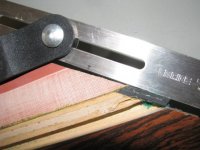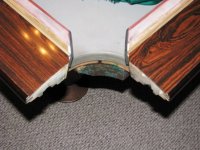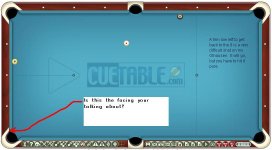You are using an out of date browser. It may not display this or other websites correctly.
You should upgrade or use an alternative browser.
You should upgrade or use an alternative browser.
All this talk about tight pockets.
- Thread starter realkingcobra
- Start date
In the diagram, I don't understand how the "rail top" is extending further out over the slate than the cushion nose. If you put a straight edge vertically from the slate bed it is going to hit the cushion nose, right? That's not what the diagram shows, so I'm confused.
Tbeaux's sketch is correct. If you look at an actual pocket from slate level, and from a viewpoint that lines up with the facing, it will look exactly as sketched. The nose of the cushion will look like a straight line running over to the facing, and the forward slope of the cushion "disappears" except for the differences in the lighted topside and shaded underside.
I think you might have interpreted the sketch incorrectly.
Roger
I think you might have interpreted the sketch incorrectly.
Roger
There's a first time for everything.
Hey Glen, When does Dallas fall in there?:thumbup:
Hold on, I got dibs on NJ first!
Tbeaux's sketch is correct. If you look at an actual pocket from slate level, and from a viewpoint that lines up with the facing, it will look exactly as sketched. The nose of the cushion will look like a straight line running over to the facing, and the forward slope of the cushion "disappears" except for the differences in the lighted topside and shaded underside.
I think you might have interpreted the sketch incorrectly.
Roger
You can see the 15 degree down angles is this picture, looking from the back of the pocket.
Attachments
I get the drawing now. Before I was looking at it as though from the pocket looking down along the rail. I had the wrong perspective.
Thanks guys :thumbup:
Thanks guys :thumbup:
You can see the 15 degree down angles is this picture, looking from the back of the pocket.
Is that a shot of one of your extended sub rails? I can't tell for sure.
Is that a shot of one of your extended sub rails? I can't tell for sure.
Yes, those subrails have been extended. And it looks like the pocket and down angles have been changed.
Yes, the rails were extended, and yes the angles were changed This is one of the reasons it's hard to rate the pockets on a table as to how hard or easy they're going to play, because as you can see in the first 2 pictures the last mechanic didn't know what he was doing when he tried to extend the rails with facings instead of wood, and couldn't cut the cushions straight, let alone at an understandable angle
This is one of the reasons it's hard to rate the pockets on a table as to how hard or easy they're going to play, because as you can see in the first 2 pictures the last mechanic didn't know what he was doing when he tried to extend the rails with facings instead of wood, and couldn't cut the cushions straight, let alone at an understandable angle


My work



My work

Justin from TAR was saying in his blog the other day that there should be a Mt. Rushmore for bad mf'ers. If there was you should be on there! You're one of those people out there that are doing God's work.
I'm already in the Porn HOF for being the biggest pain in the ass there is as a mechanic....does that count
Glen
I'm already in the Porn HOF for being the biggest pain in the ass there is as a mechanic....does that count
Glen
I am NOT going there! :groucho:
Watching Glen extend the sub-rails in order to make pocket openings smaller is a real treat. He like to talk as he works... like to teach, and I was a very interested student. Beautiful work. My Diamond has never played like this and all he did was put on new cloth... and stretch it tight. I mean T-I-G-H-T!
For anyone still having questions about pockets I compiled a thread that is posted on the "Ask a Mechanic forum". It has drawings an everything. 
http://forums.azbilliards.com/showthread.php?t=145584
Since most poeple are not able to get angular measurements I did as RKC suggested and used linear measurements.
It also has a system of ratings based on my understanding of 1) Pro organization specs, 2) the mechanics comments , 3)some Mr. Spock type logic, 4) my preferences. The ratings may seem to vary some but that is because some things appear to affect a good pocket more than others.
If RKC or any of the mechs see flaws please just post and I'll change whatever it is if it seems to make a difference.:smile:
Edit: Ohh...uhh forgive the lousey drawings but I currently only have MS Paint to work with.
http://forums.azbilliards.com/showthread.php?t=145584
Since most poeple are not able to get angular measurements I did as RKC suggested and used linear measurements.
It also has a system of ratings based on my understanding of 1) Pro organization specs, 2) the mechanics comments , 3)some Mr. Spock type logic, 4) my preferences. The ratings may seem to vary some but that is because some things appear to affect a good pocket more than others.
If RKC or any of the mechs see flaws please just post and I'll change whatever it is if it seems to make a difference.:smile:
Edit: Ohh...uhh forgive the lousey drawings but I currently only have MS Paint to work with.
Last edited:
Older Diamond v. Newer Diamond pocket sizes/play
Do the older diamonds have 4 and 9/16 size pockets? If so, how are they different from the newer diamonds?
Do the older diamonds have 4 and 9/16 size pockets? If so, how are they different from the newer diamonds?
I'm just curious as to how many of you that talk about tight pockets on your tables at home, even know what makes a pocket tight? Do you know the difference in pocket angles, and their effects? Do you understand the effects the down angle and facings have when pocketing balls? Every time I rebuild a table for someone all I'm doing is Diamondizing the tableI guess that's why I was wondering is all
Further more, do you guys understand the difference in the types of cushions, Artemis, Super-speed, Accufast...K66 & K55 profiles? Slate shelf effect? Do you understand the differences between 4" and 4 1/2" pockets? Would you believe, if I wanted to, that I can make a 4 1/4" pocketed table play tighter than a 4" pocketed table, meaning the 4 1/4" pockets would reject the balls more than a 4" pocket!
I think most everyone on here is a little lost on what makes a table tight to play on, so tell me what you know and lets see
Glen, the "realkingcobra"
Wow it sounds like you're way smarter than everyone else. i bet you're going to tell us what we've all been missing!
Do the older diamonds have 4 and 9/16 size pockets? If so, how are they different from the newer diamonds?
Yes they did, but when Diamond switched to the 3/16" neoprene facings, the pocket openings change to 4 7/16" so that's about the only changes...unless you're taking about waaaaaaay older Diamonds.
Glen
Wow it sounds like you're way smarter than everyone else. i bet you're going to tell us what we've all been missing!
I bet you're going to feel real dumb...when you realize this thread is almost a year old....and you're just NOW replying
I bet you're going to feel real dumb...when you realize this thread is almost a year old....and you're just NOW replying
i just found it today
OK, off the phone nownow back to where we were. The greater the change between the pocket opening and the back of the pocket means the greater the chance of rejecting the balls from the pocket. Keep in mind there's a difference between a tight pocket and a tuff pocket. A tight pocket is small in the opening, but will take anything fired down the middle, the offset is that you also loose cue ball angle for position when you don't have the room to angle the object ball into the pocket. The farther away from the pocket the less you can play off angle for position. Now on the other hand, a tuff pocket is one that the object balls are going in the pockets by first coming off the facings, then into the pocket, such as shooting a ball down the rails into the corner pocket. A 4" corner pocket with 46 degree angles will accept the balls much easier coming down the rails, than say a 4 1/2" corner pocket with 53 degree angles, because these kind of angles have a tendency to force the object balls across the pocket to the opposing facing then back out again, short or deep shelf, it don't really matter.
With Brunswick Gold Crowns, starting with the GC1's all the way up to the GC5's the pocket castings all have the same width across the back of the corner pockets, so how did they have some corner pockets with 5" opening, and some with 4 3/4"....by changing the pocket angles that's how, from 55 degrees down to 53 degrees. The GC5's with the "PRO" pockets are 4 9/16" and use a 52 degree pocket angle. So take the pocket opening and subtract the throat 2" back, the greater the number the more rejective the pocket is going to be.
Facings play a major role in rejecting balls from pockets as do cushions. Take the Olhausen tables for example. The cushions are very...very soft, the facings are 1/8" and very soft. What happens on an Olhausen table is that when you're attempting to pocket a ball in the corner pocket coming down the rails, you're shooting the ball right into the outer have of the pocket facing with no rail wood support behind the cushion. When you do this, what happens is that when the ball being pocketed hits the facing, instead of deflecting to-wards the back of the pocket, it compresses the facing and cushion kind of like creating a flat spot at the end of the cushion, which in turn kicks the ball across the pocket to the opposite facing and back out again, and you don't even have to shoot the shot hard to get this "rejection" to happen. So, now comes in the role of the facings. If the soft 1/8" facings are replaced with harder 3/16" neoprene facings, these facings don't compress nearly as much when you shoot a ball into them, so the balls that would normally reject....go in because they deflect off the facings deeper into the back of the pocket.
I have an 8' Olhausen and have had many runs stopped by a corner pocket rattle. Check out the attachment. Is this the area you're talking about?
Attachments
toughness of diamond pro-am 9ft
Hey Glenn,
Just have a question for you.... I purchased a 9 foot diamond pro-am last June. It had been set up at Turning Stone last January and then went to Valley Forge the following March. Is there any way you can tell me the exact pocket size, shelf, angle, etc... of my table. I guess I'm just curious to know how tough of a table it really is, or is not... I am used to it and find it easy to make balls....
Erica
i just found it today
Hey Glenn,
Just have a question for you.... I purchased a 9 foot diamond pro-am last June. It had been set up at Turning Stone last January and then went to Valley Forge the following March. Is there any way you can tell me the exact pocket size, shelf, angle, etc... of my table. I guess I'm just curious to know how tough of a table it really is, or is not... I am used to it and find it easy to make balls....
Erica

